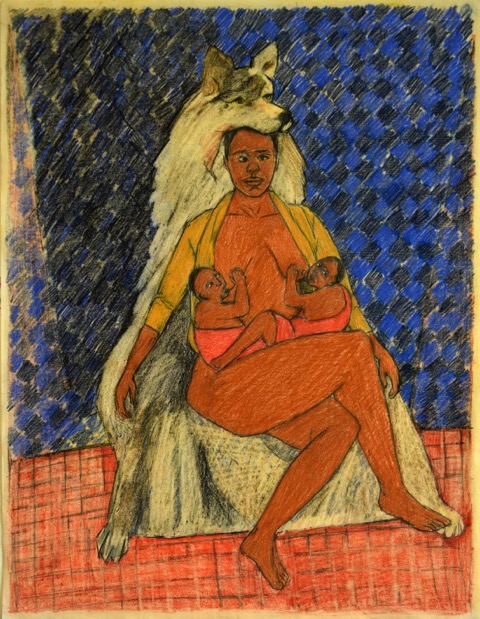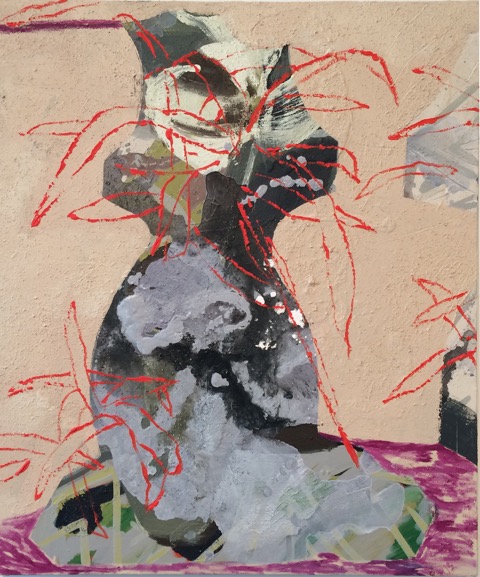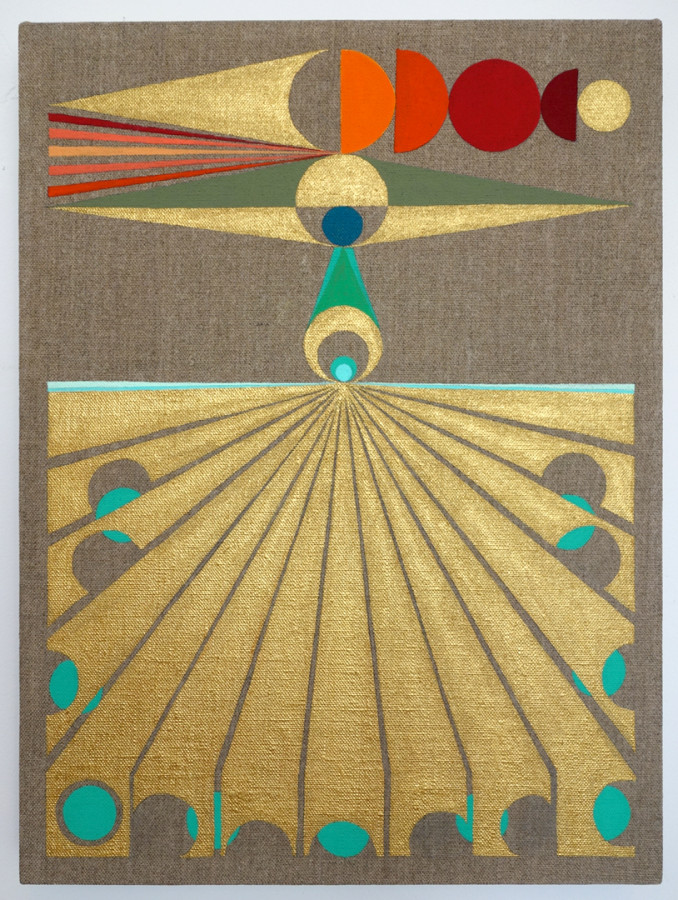Artadia was pleased to present work at NADA Miami Beach 2015 by four Awardees, paired with reflections from the curators that selected them as Awardees.

Mequitta Ahuja
Lupa II, 2014
colored pencil on paper
22 inches x 17 inches
Many visitors to artistic hubs of the Italian Renaissance, such as Rome, Florence and Sienna, are taken immediately with the great sweep of Western cultural heritage laid out before them. Accumulations of architectural foundations reach far beneath the level of modern streetscapes. At times they peak well above them, as seemingly immovable ancient foundations are built upon and incorporated into Gothic and Renaissance era structures. These later buildings, integrating randomly scavenged antique sculptural fragments may be, in turn, capped by modern dwellings, adding a distinct contemporaneity to this layering effect. Over time, while the jumbled results of decay, salvage and re-incorporation are temporarily confounding, a sense of an historical lineage remains.
In many ways, a recent body of works on paper by Mequitta Ahuja operates analogously to the capping effect of later generations of builders. These drawings figure the artist in formalized poses not unfamiliar to those of us interested in art history. At times, her self-representation channels Gauguin, at others, ancient goddesses. Drawings from this series take on distinct characteristics of 14th century Italian Gothic painting. Flat planes of color, hierarchies of importance distinguished through scale, and a similarly nascent use of single-point perspective are her main devices. But an unconventional representation inhabits each of them, which is that of the artist herself. Ahuja’s adept incorporation of history in both her drawings and large-scale paintings reminds us of tacit assumptions about formulaic representations in Western iconography, just as it does about stylistic appropriations of non-Western aesthetics in key movements of Western art. Like the artisans and architects of past millennia, who scavenged, reused and reordered fragments of past civilizations at hand to them, Ahuja’s insertion of a new iconography into the historical plane can be seen to complicate, build on, and augment this history in contemporary terms, as a founder, builder and creator. -Christopher Eamon

Larissa Bates
Yalies in Golfito, 2012
Gouache and gold leaf on panel
10 inches x 8 inches
Larissa Bates’ paintings contain multitudes, playing the biographical off the social, the decorative off the symbolic, the history of art off the contemporary. Allowing for personal narrative and social and political subtexts, they are intensely beautiful objects. There is a specificity, a haptic exuberance and sophistication that can only be experienced by way of an encounter with the paintings themselves. Generally they are delicate and precise gouaches on linen or board, small in scale and influenced in form most readily by Persian miniatures, but also Dutch still lives, French
Baroque, and Italian Rococo. With all of these influences, even the most serene such as Dutch flower drawings, the initiate will understand that there are codes to be deciphered and ideological positions being described, and Bates mines this sensibility in her own narrative and allegorically inflected works. On the level of content, Bates has taken the surprising capaciousness of the miniature to heart, and allows herself to incorporate influences as diverse as the gender questioning in the work of contemporary artists such as Wu Tsang, Collier Shorr, Nicole Eisenman; or the narrative complexity and playful creation of deeply subjective worlds of artists such as Layla Ali and Trenton Doyle Hancock. Non-perspectival, the paintings are narrative tableaus, and exist in accumulating series, related to each other though evolving thematically with the artist’s concerns.
Bates’ mother was Costa Rican and died when the artist was young, creating a twin sense of loss — of her mother, but also the cultural world that she was a conduit to. Largely raised by her father, the artist was for some time concerned to explore the limits of masculine representation: the connections between an assertive masculinity and the violence of colonialism. She created series with MotherMen (idealized wrestlers, with the capacity to cry and lactate) or Little Napoleans (multiplying characters dedicated to the destruction of the MotherMen and the taking over of land). More recently, she has explored her own family’s history as collaborators with colonial expansion; her great-great-grandfather was vice president of United Fruit, the company whose exploitative labor and land policies underwrote the concept of the Banana Republic. She is able to reflect on and gently mock the role that gender formations have played in preserving and justifying the social psychological violence of such exploitation. Encountering Bates’ paintings, one senses an artist who is developing a unique and valuable vision that will one day accumulate to a world. -Bartholomew Ryan

Angelina Gualdoni
Slip, 2015
acrylic on canvas
28 inches x 24 inches
Since 2009, Angelina Gualdoni has made works that have moved away from representational painting. Early series for instance depicted utopian architecture and urban ruins. Gualdoni then shifted to non-objective paintings and explored pattern. Over time, Gualdoni has become more assertive in allowing the paint to guide the painting. I take this as a sign of confidence that the artist has comfort in managing the unpredictable consequences of paint acting on its own.
Gualdoni’s paintings now offer the expressive qualities of paint in combination with the artist’s skill to collaborate with process. This give and take rewards within compelling, complex images. In this, Gualdoni’s recent work reminds me of artists such as Sam Francis, who also poured paint regularly. The other connection I make is to Bay Area Figurative painters such as Joan Brown who revolted against the formalist New York Abstract Expressionism of her time. In my mind, bringing the figure back into the conversation indicated a kind of west coast populism that respected the need for an average viewer to find something recognizable in the work before them.
Gualdoni’s recent paintings are elegant and self-assured. They show interior scenes and still lifes. As I write, I look to the side of my computer at the various orchids on my desk. All are in a dormant stage but one readying to reveal its flowers to the world. Gualdoni’s paintings evoke this feeling that I am having. It’s a moment when the everyday opens to reverie. -René de Guzman

Eamon Ore-Giron
Infinite Regress II, 2015
Flashe on linen
17 inches x 12 inches
Eamon Ore-Giron’s new sequence of paintings is titled Infinite Regress, as if to relay how contingency, deferral, and ultimately a return — or even synthesis — may be the choreography of abstract composition. Ore-Giron has been honing his abstract paintings while simultaneously embarking on a multi-year research project centered in (and about) Morococha, Peru, where an entire village has been displaced through transnational corporate encroachment of copper in the region and a place with personal connections for the artist. With that in mind, Ore-Giron’s connection to abstraction cannot be divorced from the various multidisciplinary and hybrid modes at work in his practice.
In 2012, for his residency and exhibition at 18th Street Art Center, the abstract forms first emerged in response to various histories of modernism, both elevated versions drawn from the Latin American artistic canon and more vernacular renditions as seen in public monumental sculptures found in plazas and municipal buildings. Ore-Giron’s residency and resulting exhibition E-D-G-B-D-G mixed the lexicons of geometric abstraction with his own “tracing (of) an alternative map of the global South.”
Although the role of noise and mixed compositional components has been worked out through his various DJ and conceptual projects related to music, Ore-Giron’s paintings are sharp and controlled compositions. The Flashe on linen canvases often involve repeating circular forms painted in vivid hues. The rays and triangular extensions that emerge from the dotted forms in this new body of work are golden streaks that bring to mind the luster of Baroque art. The various neologisms that Ore-Giron has used to describe his influences and his output, including “Tropical Punk Morphology” and “Andean Maoist Folkology,” are the ultimate idiosyncratic yet succinct terms to describe how the paintings distill yet retain the chaos of cultural shock. -Rita Gonzalez
Read the full PDF of the NADA booklet here. There are a limited number of these available. Please reach out to us at info@artadia.org if you would like to receive a hard copy.




